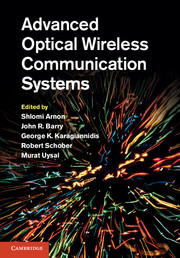13 - Optical modulating retro-reflectors
from Part IV - Applications
Published online by Cambridge University Press: 05 June 2012
Summary
Introduction
Free-space optical communication (FSO) offers many potential advantages. These include: high bandwidth, security, non-interference, and a large amount of available spectrum. Many of these advantages are related to optics' short wavelength relative to radio-frequency (RF) or microwave systems. At optical wavelengths even a small transmit aperture can produce highly directional beams, and optical receivers can focus light down to very small spots. To make use of this high optical antenna gain very good pointing is required. Even a small telescope, with a 1 cm diameter, has a diffraction-limited beam divergence of less than 250 micro-radians in the near-infrared. Pointing with this accuracy is challenging, particularly if one or both ends of the link are in motion. Active FSO systems with high pointing accuracy are often large, heavy, and have high power consumption [1]. Such systems are also complex, which can lead to reliability issues.
Despite these challenges, direct FSO links – those with active terminals on both ends – have many good applications. There are, however, other applications in which the two ends of the link have different payload and power capabilities. Some examples include: unattended sensors, small unmanned aerial vehicles (UAVs), and small, tele-operated robots. For these applications a modulating retro-reflector (MRR) may be an appropriate solution.
Optical MRRs couple passive retro-reflectors with electro-optic modulators to allow long-range, free-space optical communication with a laser, and pointing/acquisition/tracking system, required on only one end of the link. As shown in Figure 13.1, a conventional free-space optical communications terminal, the interrogator, is used on one end of the link to illuminate the MRR on the other end of the link with a continuous-wave beam.
- Type
- Chapter
- Information
- Advanced Optical Wireless Communication Systems , pp. 328 - 350Publisher: Cambridge University PressPrint publication year: 2012
- 5
- Cited by



